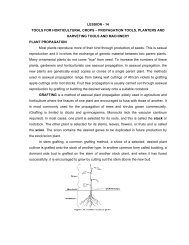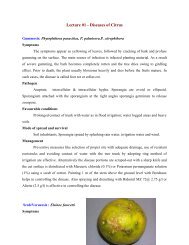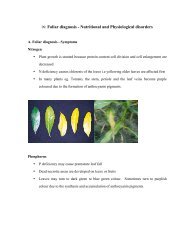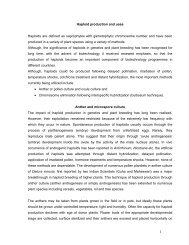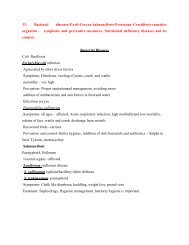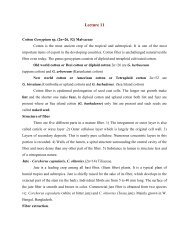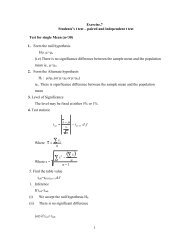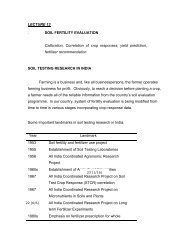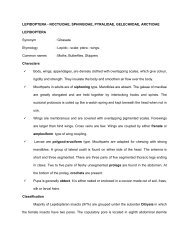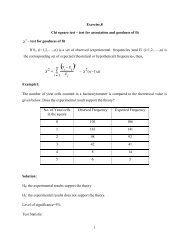Sweet Sorghum - Tamil Nadu Agricultural University
Sweet Sorghum - Tamil Nadu Agricultural University
Sweet Sorghum - Tamil Nadu Agricultural University
You also want an ePaper? Increase the reach of your titles
YUMPU automatically turns print PDFs into web optimized ePapers that Google loves.
later stage and continues<br />
up to maturity. Shootfly<br />
attack is noted by<br />
deadhearts in seedlings<br />
and heavy tillering in<br />
affected plants later.<br />
Shoot fly is controlled<br />
with the application of<br />
Carbofuran 2G @ 8-10<br />
kg ha-1 during planting either along the furrow<br />
(in furrow sowing) or in a shallow furrows cut on<br />
the ridge (in ridge planting). The same<br />
insecticide could be applied in leaf whorls (2-3<br />
granules/whorl) based on the foliar injury<br />
symptoms, to prevent stem borer tunneling.<br />
DISEASE MANAGEMENT<br />
Downy Mildew<br />
Rust<br />
Spray Mancozeb at 1 kg/ha when the disease<br />
reached grade 3. Repeat fungicidal application<br />
after 10 days.<br />
HARVEST<br />
The earhead should be<br />
harvested at<br />
physiological maturity<br />
and sundried for<br />
removing excess moisture<br />
in the grain. The green<br />
cane should be cut at the<br />
ground level and sent to<br />
the mill for crushing at the earliest as the sugar<br />
content decrease in progression with time. In any<br />
case it should be crushed before 48 hrs failing<br />
which sugar content will be drastically reduced.<br />
SWEET SORGHUM<br />
PRODUCTION TECHNOLOGY<br />
Seed treatment with Metalaxyl at 4 g/kg of<br />
seed. Rogue out infected plants upto 45 days<br />
after sowing and spray Metalaxyl 500g or<br />
Mancozeb 1kg or Ziram 1kg or Zineb<br />
1 kg/ha. Spray Mancozeb 1250 g/ha after<br />
noticing the symptoms of foliar diseases, for<br />
both transplanted and direct sown crops.<br />
Head Mould<br />
Spray any one of the following fungicides in<br />
case of intermittent rainfall during earhead<br />
emergence and a week later. Mancozeb 1<br />
kg/ha, Zineb 1 kg/ha, Captan 1 kg/ha +<br />
Aureofungin sol 100 g/ha.<br />
Sugary disease<br />
Sowing period to be adjusted so as to prevent<br />
heading during rainy season and severe winter.<br />
Spray any one of the following fungicide at<br />
emergence of earheads (5 10 % flowering<br />
stage) followed by a spray at 50% flowering<br />
and repeat the spray after a week if necessary.<br />
Ziram 1 kg/ha, Mancozeb 1 kg/ha, Zineb 1<br />
kg/ha.<br />
FOR SEEDS PLEASE CONTACT<br />
Varity SSV 84<br />
Department of Millets<br />
Centre for Plant Breeding & Genetics<br />
<strong>Tamil</strong> <strong>Nadu</strong> <strong>Agricultural</strong> <strong>University</strong>, Coimbatore - 3.<br />
National Research Centre for <strong>Sorghum</strong><br />
Rajendra Nagar, Hyderabad - 500 030.<br />
M/s. Bannari Amman Sugars Ltd.,<br />
252, Mettupalayam Road, Coimbatore - 43.<br />
M/s. S.V. Sugar Mills Ltd.,<br />
Palayaseevaram - 631 606, Kanchipuram Dt.<br />
M/s. Sakthi Sugars Ltd.,<br />
Jothi Nagar, Padamathur - 630 561, Sivagangai Dt.<br />
M/s. Mohan Breveries & Distilleries Ltd.,<br />
158, Anna Salai, Chennai - 600 002.<br />
Madura Hybrid<br />
Nimkar <strong>Agricultural</strong> Research Insitute<br />
Post Box : 44, Phaltan - 415 523.<br />
Maharashtra.<br />
Note :<br />
The sowing of the frop is to be adjusted so that the flowering should not be<br />
coincide with rains.<br />
FOR MORE DETAILS PLEASE CONTACT<br />
Professor and Head<br />
Department of Millets<br />
Centre for Plant Breeding & Genetics<br />
<strong>Tamil</strong> <strong>Nadu</strong> <strong>Agricultural</strong> <strong>University</strong><br />
Coimbatore - 641 003.Ph : 0422 - 2450507,<br />
E-mail : millets@tnau.ac.in directorcpbg@tnau.ac.in<br />
Laser Park, Cbe. Ph ; 2554898<br />
Department of Millets<br />
Centre for Plant Breeding and Genetics<br />
<strong>Tamil</strong> <strong>Nadu</strong> <strong>Agricultural</strong> <strong>University</strong><br />
Coimbatore - 641 003.
INTRODUCTION<br />
<strong>Sorghum</strong> (S. bicolor) is the most important millet<br />
crop occupying largest area among the cereals<br />
next to rice. It is mainly grown for its grain and<br />
fodder. Alternative uses of sorghum include<br />
commercial utilization of grain in food industry<br />
and utilization of stalk for the production of<br />
value-added products like ethanol, syrup and<br />
jaggery and bioenriched bagasse as a fodder<br />
and as a base material for cogeneration.<br />
Utilization of sorghum grain as animal and<br />
poultry feed has dramatically increased due to<br />
the price competition from maize. Similarly,<br />
demand for industrial and potable alcohol is<br />
continuously increasing. The recent policy of<br />
Government for blending of alcohol in petrol at<br />
the rate of 5 percent increased the demand for<br />
alternative and commercially feasible raw<br />
materials such as sweet sorghum. <strong>Sweet</strong><br />
sorghum has emerged as a supplementary crop<br />
to sugarcane in dry land pockets for the<br />
production of ethanol. The advantages of the<br />
crop are: I) it can be grown with limited water<br />
and minimal inputs, ii) it can be harvested in<br />
four months. <strong>Sweet</strong> sorghum is gaining the<br />
world attention as a promising bio-energy crop<br />
and alternative raw material for the production<br />
of alcohol. The success rate is high because of<br />
the use of existing machinery available in the<br />
sugar factories and attached distilleries. <strong>Sweet</strong><br />
sorghum juice also can be used for the<br />
production of syrup called "sorghum honey".<br />
Farmers, in a manner similar to jaggery<br />
preparation can prepare sorghum honey.<br />
Bagasse can be enriched and sold as cattlefeed.<br />
It is also a highly suitable base material for<br />
cogeneration. Similarly, use of grain as an<br />
alternate raw material for the production of<br />
potable alcohol is promising and receiving<br />
importance for use as biofuel.<br />
SWEET SORGHUM VARIETIES<br />
<strong>Sweet</strong> sorghum stalk<br />
are juicy and rich in<br />
fermentable sugars as<br />
high as 15-18 per cent<br />
and has potential for<br />
cane yield of 40 t/ha<br />
or more.<br />
Projected<br />
uses of sweet sorghum are production of alcohol,<br />
syrup and jaggery from the stalk juice. The<br />
recovery of alcohol in the pilot run showed 9<br />
0<br />
percent of the juice having a brix of 12 .<br />
So far SSV 84 is the only<br />
one variety has been<br />
released through All<br />
India Coordinated<br />
<strong>Sorghum</strong> Improvement<br />
Project by the National<br />
Research Centre for<br />
<strong>Sorghum</strong> at Hyderabad.<br />
The important sweet sorghum varieties released at<br />
international level are Rio, Dale, Brandes, Theis,<br />
Roma, Vani, Ramada and Keller. BJ 248, RSSV 9,<br />
NSSV 208, NSSV 255 and RSSV 56 are the sweet<br />
sorghum cultures identified by the All India<br />
Coordinated sorghum improvement project at<br />
National level. Hybrid Madhura developed by<br />
Nimkar <strong>Agricultural</strong> Research Institute, Phaltan,<br />
Maharashtra is a popular hybrid in <strong>Sweet</strong><br />
<strong>Sorghum</strong>. The TNAU has developed a <strong>Sweet</strong><br />
<strong>Sorghum</strong> VMS 98003 with a cane yield of 45.7<br />
t/ha and ethanol yield of 3.6 kl/ha as a promising<br />
sweet sorghum variety for <strong>Tamil</strong> <strong>Nadu</strong> and is being<br />
tested under Adaptive Research Trial and will be<br />
released soon. Most of these varieties matures in<br />
100-110 days.<br />
CLIMATE AND SOIL<br />
<strong>Sweet</strong> sorghum can be<br />
sown during June,<br />
coinciding with the<br />
south-west monsoon,<br />
September October<br />
during northeast<br />
monsoon with a rainfall of 500-600 mm well<br />
distributed across the growing period and also<br />
during summer with assured irrigation. The crop<br />
does not prefer high rainfall as high soil moisture or<br />
continuous heavy rain after flowering may hamper<br />
sugar increase. If irrigation is available, sowing<br />
can be advanced before June so that the crop does<br />
not face heavy rains after flowering and more so<br />
during the last half of grain maturing period.<br />
Sowing during summer season may result in low<br />
biomass and sugar yield. All soils that have medium<br />
depth (18" and above) with good drainage are<br />
suited. Depending on the soil (red, black, laterite<br />
and loamy) and its depth water requirement may<br />
vary which in turn decide the suitability of the crop.<br />
SEED RATE<br />
For better productivity the<br />
optimum spacing should be 45<br />
cm x 15 cm with a seed rate of<br />
10 kg/ha.<br />
SEED TREATMENT<br />
Treat the seeds with Carbendazim (or) Thiram @<br />
2gm/kg of seed. Treat the seeds with 2% KH2PO4<br />
for 6 hours as pre sowing treatment under rainfed<br />
condition. Before sowing, treat the seeds with<br />
azospirillum @ 600 gm/ha.<br />
SOWING<br />
Can be done on ridges and furrows at a spacing of<br />
45 cm between rows and 15 cm within rows. Three<br />
to four seeds are dibbled in each hill/planting<br />
hole and the seedlings are to be eventually<br />
thinned to one per hill. If a planter is used, then<br />
the existing seed rate can be further reduced.<br />
FERTILIZATION<br />
Recommended<br />
dose of fertilizer<br />
for sweet<br />
sorghum in soils<br />
with normal<br />
fertility level is<br />
120 kg nitrogen,<br />
40kg phosphorus<br />
and 40 kg potassium. Half of N and whole of P<br />
and K are applied as basal. Remaining N is to<br />
be top-dressed during 25-30 days after<br />
germination, following weeding and intercultivation.<br />
WEED MANAGEMENT<br />
Atrazine @ 0.2 kg ai/ha can be applied as pre<br />
emergence herbicide at 3 days after sowing<br />
followed by hand weeding at 45 days after<br />
sowing.<br />
IRRIGATION<br />
Irrigation should be based on available soil<br />
moisture, which depends on the type of soil and<br />
the rainfall distribution. Minimum of 6 to 7<br />
irrigations are required with an interval of<br />
7 -10 days.<br />
PEST MANAGEMENT<br />
Major pests are sorghum shootfly and stem<br />
borer. Shoot fly attacks soon after germination<br />
up to 30 days. Stem borer incidence may be at a



